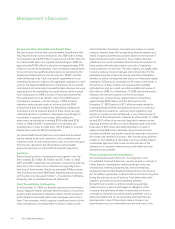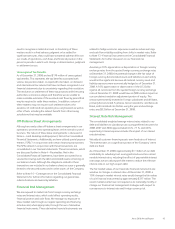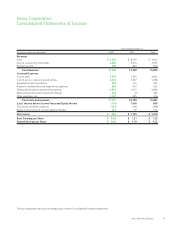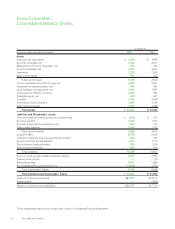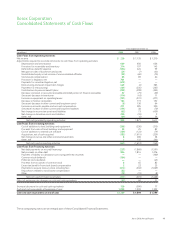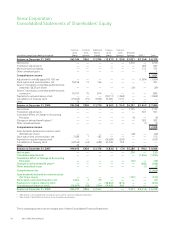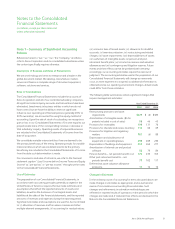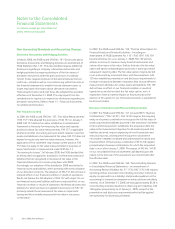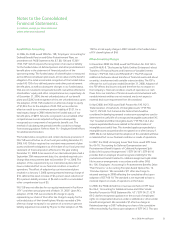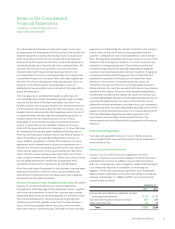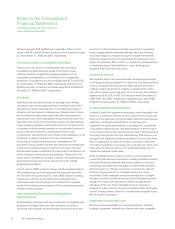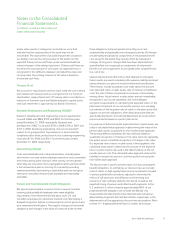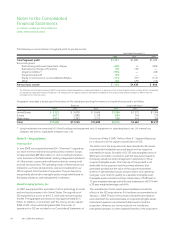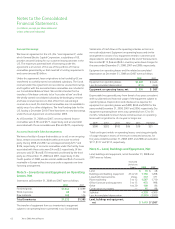Xerox 2008 Annual Report Download - page 54
Download and view the complete annual report
Please find page 54 of the 2008 Xerox annual report below. You can navigate through the pages in the report by either clicking on the pages listed below, or by using the keyword search tool below to find specific information within the annual report.
Notes to the Consolidated
Financial Statements
(in millions, except per share data and
unless otherwise indicated)
New Accounting Standards and Accounting Changes
Derivative Instruments and Hedging Activities
In March 2008, the FASB issued SFAS No. 161 “Disclosures about
Derivative Instruments and Hedging Activities an amendment of
FASB Statement No. 133”. The new standard requires additional
disclosures regarding a company’s derivative instruments and
hedging activities by requiring disclosure of the fair values of
derivative instruments and their gains and losses in a tabular
format. It also requires disclosure of derivative features that are
credit risk – related as well as cross-referencing within the notes to
the financial statements to enable financial statement users to
locate important information about derivative instruments,
financial performance and cash flows. We adopted this standard
effective as of December 31, 2008. The only impact from this
standard was to require us to expand our disclosures regarding our
derivative instruments. Refer to Note 13 – Financial Instruments
for additional information.
Fair Value Accounting
In 2006, the FASB issued SFAS No. 157, “Fair Value Measurements”
(“FAS 157”). We adopted the provisions of FAS 157 on January 1,
2008. FAS 157 defines fair value, establishes a market-based
framework or hierarchy for measuring fair value and expands
disclosures about fair value measurements. FAS 157 is applicable
whenever another accounting pronouncement requires or permits
assets and liabilities to be measured at fair value. FAS 157 does not
expand or require any new fair value measures; however, the
application of this statement may change current practice. FAS
157 does not apply to fair value measurements for purposes of
lease classification or measurement under SFAS No. 13,
“Accounting for Leases”. In February 2008, the FASB decided that
an entity need not apply this standard to nonfinancial assets and
liabilities that are recognized or disclosed at fair value in the
financial statements on a nonrecurring basis until 2009.
Accordingly, our adoption of this standard in 2008 was limited to
financial assets and liabilities, which primarily affects the valuation
of our derivative contracts. The adoption of FAS 157 did not have a
material effect on our financial condition or results of operations.
We do not believe the full adoption of FAS 157 with respect to our
nonfinancial assets and liabilities will have a material effect on our
financial condition or results of operations. Nonfinancial assets and
liabilities for which we have not applied the provisions of FAS 157
primarily include those measured at fair value in impairment
testing and those initially measured at fair value in a business
combination.
In 2007, the FASB issued SFAS No. 159, “The Fair Value Option for
Financial Assets and Financial Liabilities – Including an
Amendment of FASB Statement No. 115” (“FAS 159”). FAS 159
became effective for us on January 1, 2008. FAS 159 permits
entities to choose to measure many financial instruments and
certain other items at fair value. Entities that elect the fair value
option will report unrealized gains and losses in earnings at each
subsequent reporting date. The fair value option may be elected
on an instrument-by-instrument basis, with few exceptions. FAS
159 also establishes presentation and disclosure requirements to
facilitate comparisons between companies that choose different
measurement attributes for similar assets and liabilities. FAS 159
did not have an effect on our financial condition or results of
operations as we did not elect this fair value option, nor is it
expected to have a material impact on future periods as the
election of this option for our financial instruments is expected to
be at most, limited.
Business Combinations and Noncontrolling Interests
In 2007, the FASB issued SFAS No. 141 (revised 2007), “Business
Combinations” (“FAS 141(R)”). FAS 141(R) requires the acquiring
entity in a business combination to recognize the full fair value of
assets acquired and liabilities assumed in the transaction (whether
a full or partial acquisition); establishes the acquisition-date fair
value as the measurement objective for all assets acquired and
liabilities assumed; requires expensing of most transaction and
restructuring costs; and requires the acquirer to disclose the
information needed to evaluate and understand the nature and
financial effect of the business combination. FAS 141(R) applies
prospectively to business combinations for which the acquisition
date is on or after January 1, 2009. The impact of FAS No. 141(R)
on our consolidated financial statements will depend upon the
nature, terms and size of the acquisitions we consummate after
the effective date.
In 2007, the FASB issued SFAS No. 160, “Noncontrolling Interests
in Consolidated Financial Statements – an amendment of
Accounting Research Bulletin No. 51” (“FAS 160”). FAS 160 requires
reporting entities to present noncontrolling (minority) interests as
equity (as opposed to as a liability) and provides guidance on the
accounting for transactions between an entity and noncontrolling
interests. As of December 31, 2008, we had approximately $120 in
noncontrolling interests classified in other long-term liabilities. FAS
160 applies prospectively as of January 1, 2009, except for the
presentation and disclosure requirements which will be applied
retrospectively for all periods presented.
52 Xerox 2008 Annual Report




